Pavlova
This post may contain affiliate links. Read my full disclosure policy.
Dress up your dessert table with a gorgeous pavlova—a cloud-like dessert featuring a crisp, marshmallowy meringue topped with rich whipped cream and vibrant berries, perfect for any special occasion. (Bonus: it’s gluten-free!)
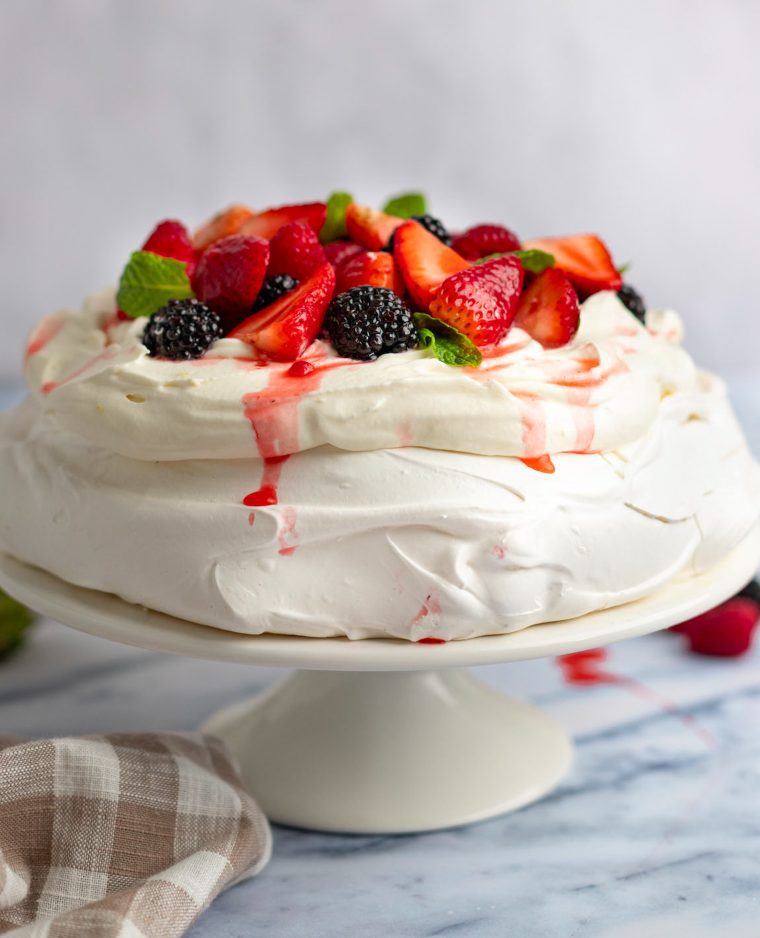
Pavlova, named after the Russian ballerina Anna Pavlova, is a wonderfully light dessert with a crisp meringue shell encasing a soft, marshmallowy center, all topped with heaps of whipped cream and fresh fruit. Believed to have been created in the ballerina’s honor during her tours of Australia and New Zealand in the 1920s, it’s as stunning as it is delicious—perfect for any special occasion.
While the classic pavlova recipe typically includes meringue, whipped cream, and fruit, I have a couple of tricks to really enhance its flavor and texture. First, I enrich the whipped cream with a bit of mascarpone cheese, giving the dessert an extra layer of richness and creaminess that makes it feel more luxurious and substantial. Second, I macerate the berries in sugar and lemon juice. It’s a simple and optional step, but it deepens their sweetness and makes the whole dessert pop—definitely worth it if you have the time.
Table of Contents
What You’ll Need To Make Pavlova
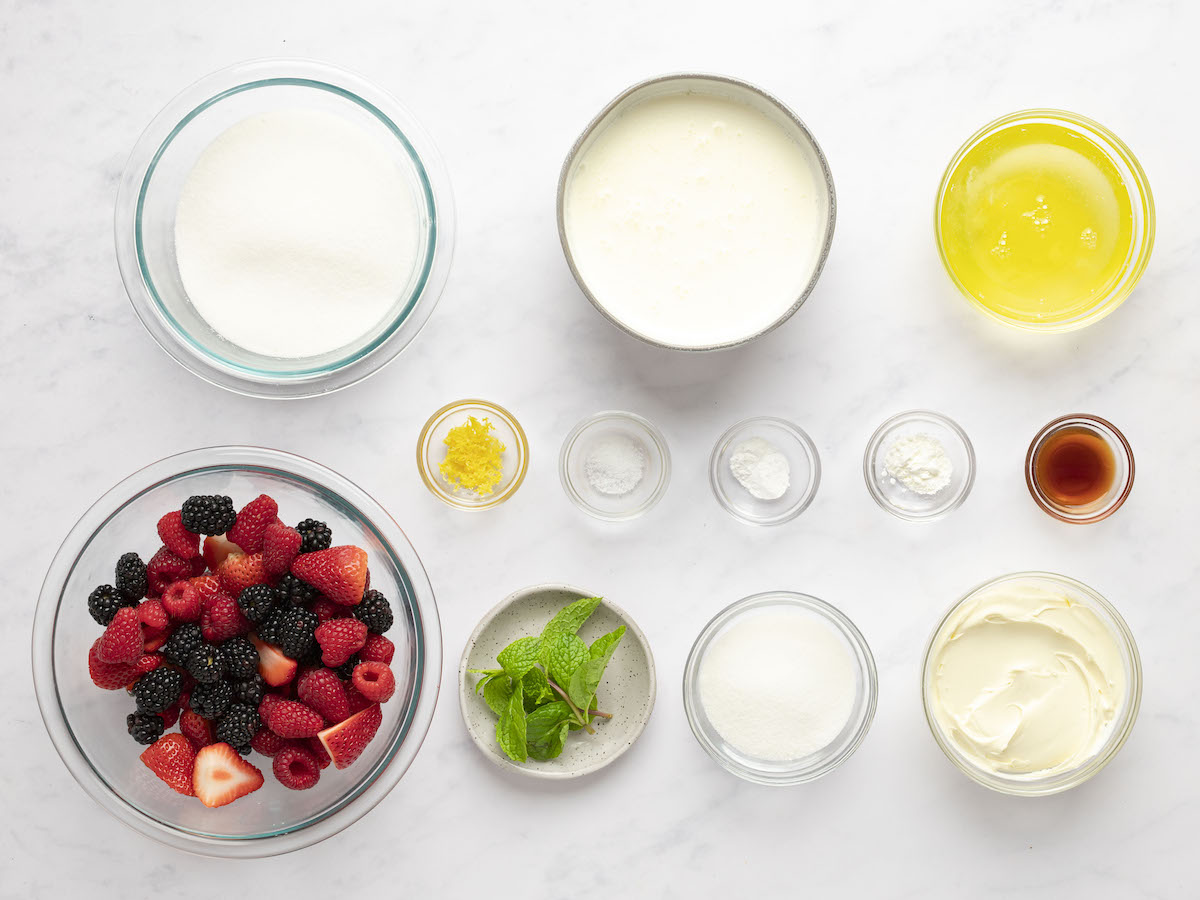
- Egg Whites: The foundation of the pavlova, which provides structure and volume, and creates the crisp shell. Save the leftover yolks for another recipe, like crème brûlée.
- Cream of Tartar: Stabilizes the egg whites, ensuring they hold their shape and form.
- Superfine Sugar: Sweetens and contributes to the pavlova’s texture, helping it achieve a delicate, crisp exterior and a soft, marshmallow-like interior.
- Vanilla Extract: Adds flavor to the pavlova, enhancing its overall taste.
- Cornstarch: Helps to stabilize the pavlova’s structure and creates a fluffy center beneath the crisp exterior.
- Mascarpone Cheese: Adds richness and creaminess to the pavlova’s topping, and complements the sweetness of the base.
- Heavy Cream: Serves as the primary ingredient for creating the whipped topping’s light and airy texture.
- Granulated Sugar: Sweetens the whipped cream, balancing the flavors of the dessert.
- Lemon Zest: Provides a subtle citrusy aroma and flavor to the whipped topping.
- Mixed Berries: Add a burst of freshness, vibrant color, and natural sweetness to the pavlova.
- Jump to the printable recipe for precise measurements
Step-By-Step-Instructions For Pavlova
Step 1: Make the Meringue Base
Preheat the oven to 250°F and set an oven rack in the middle position.
Line a baking sheet with parchment paper. Using a dark marker, draw a 9-inch diameter circle on the parchment paper by tracing around a 9-inch cake pan or plate. Flip the paper over so your meringue won’t touch the marker. Set aside.
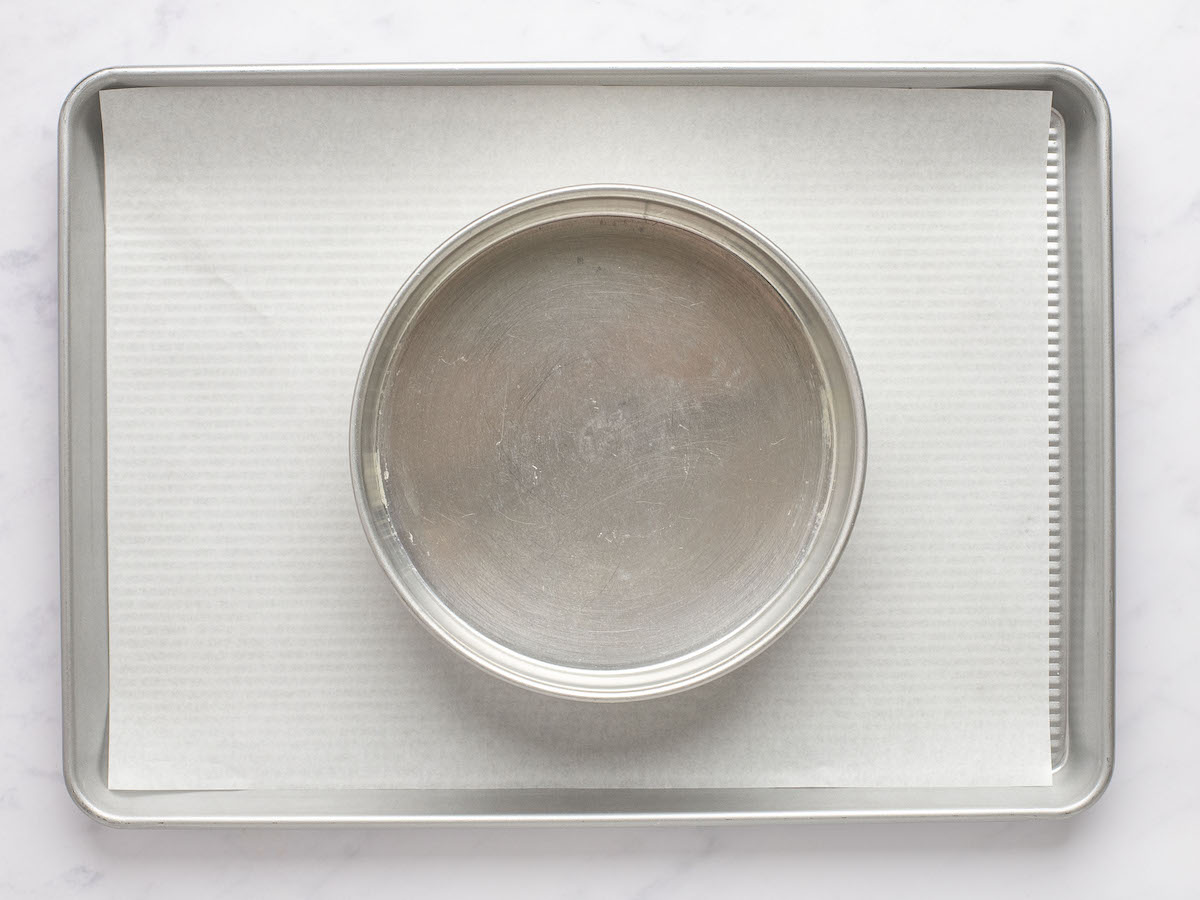
Add the egg whites to the bowl of a stand mixer.
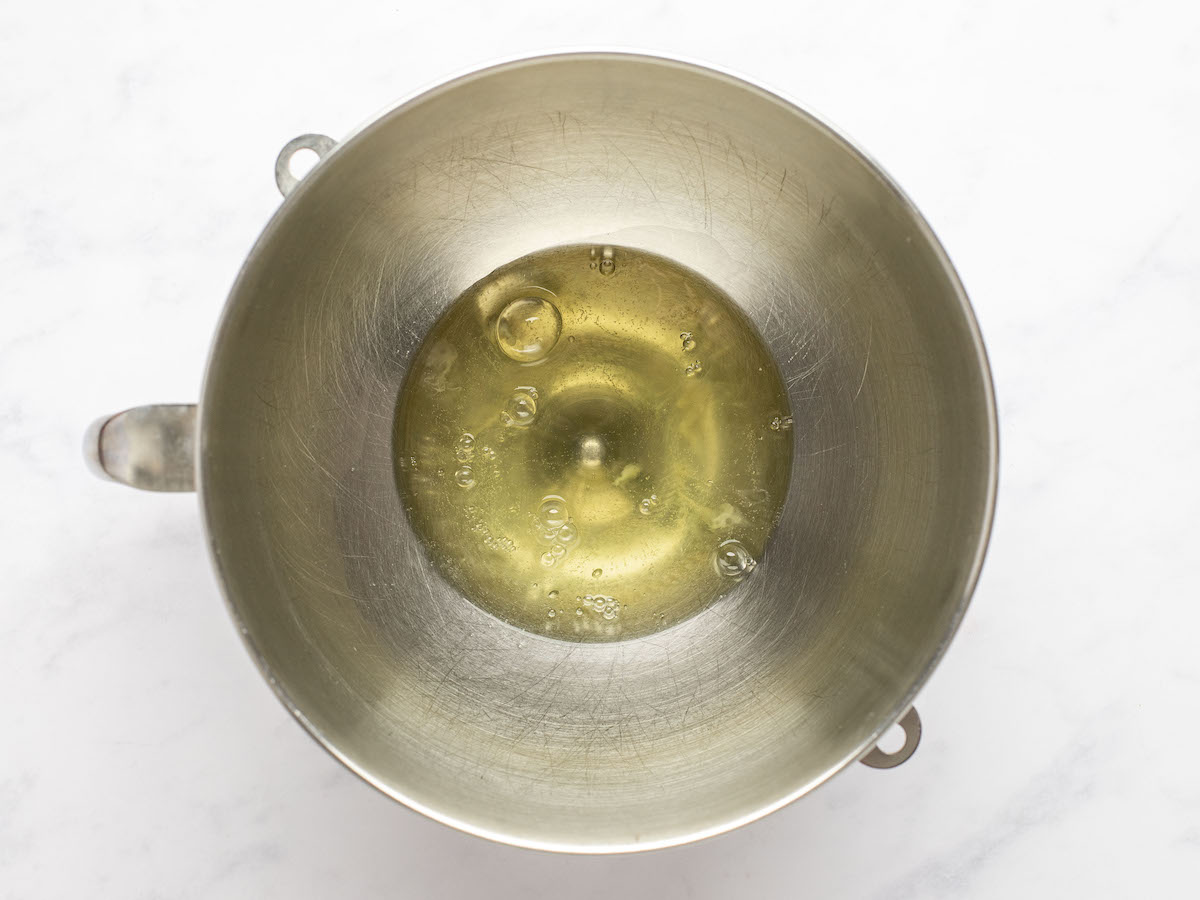
Beat on medium speed (6) until the egg whites become foamy, about 1 minute. Add the salt and cream of tartar.
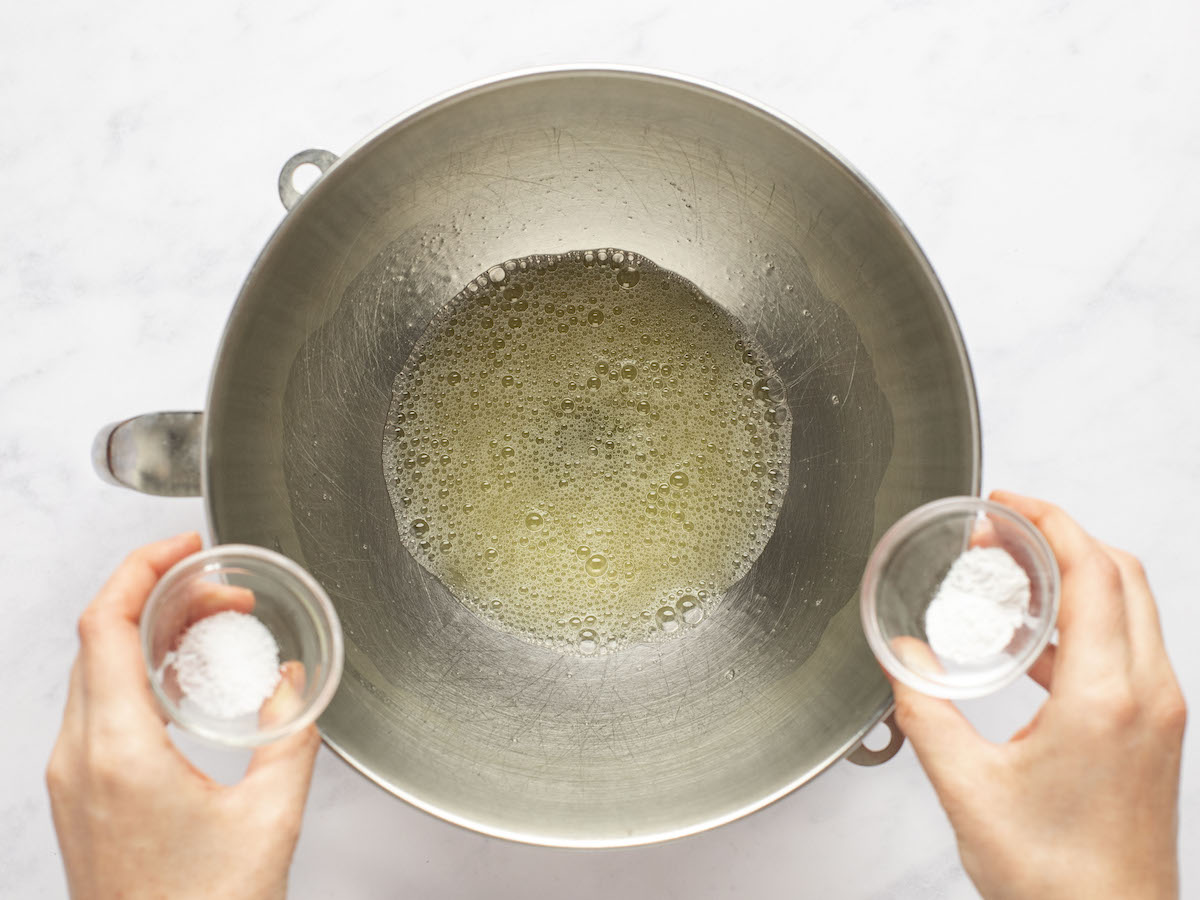
Beat until the mixture forms soft peaks, about 2 minutes. Gradually add the granulated sugar, about one tablespoon at a time.
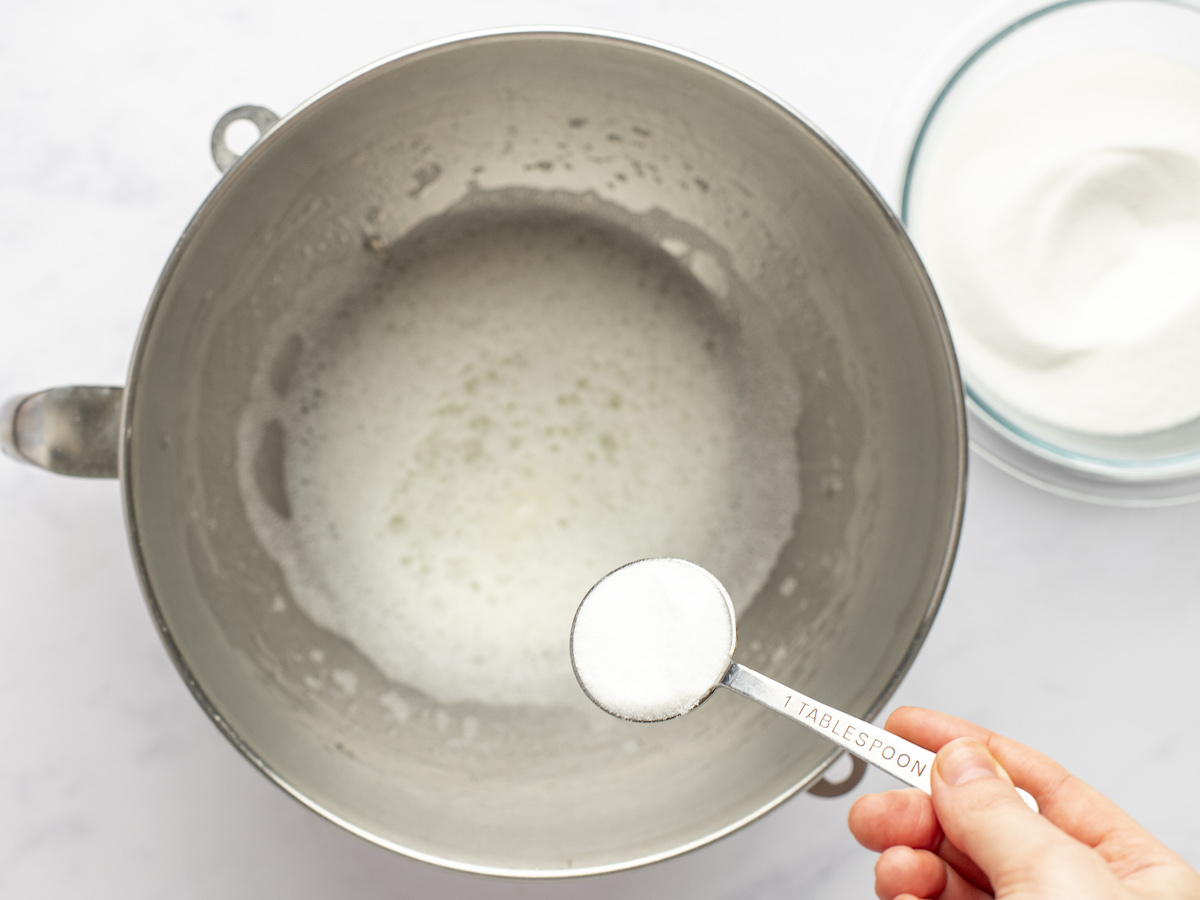
Once all the sugar is added, increase the speed to medium-high (8) and beat until the meringue is glossy and holds stiff peaks, 5 to 7 minutes more. (When you lift the beater out of the bowl, the meringue should form peaks that stand straight up without drooping.)
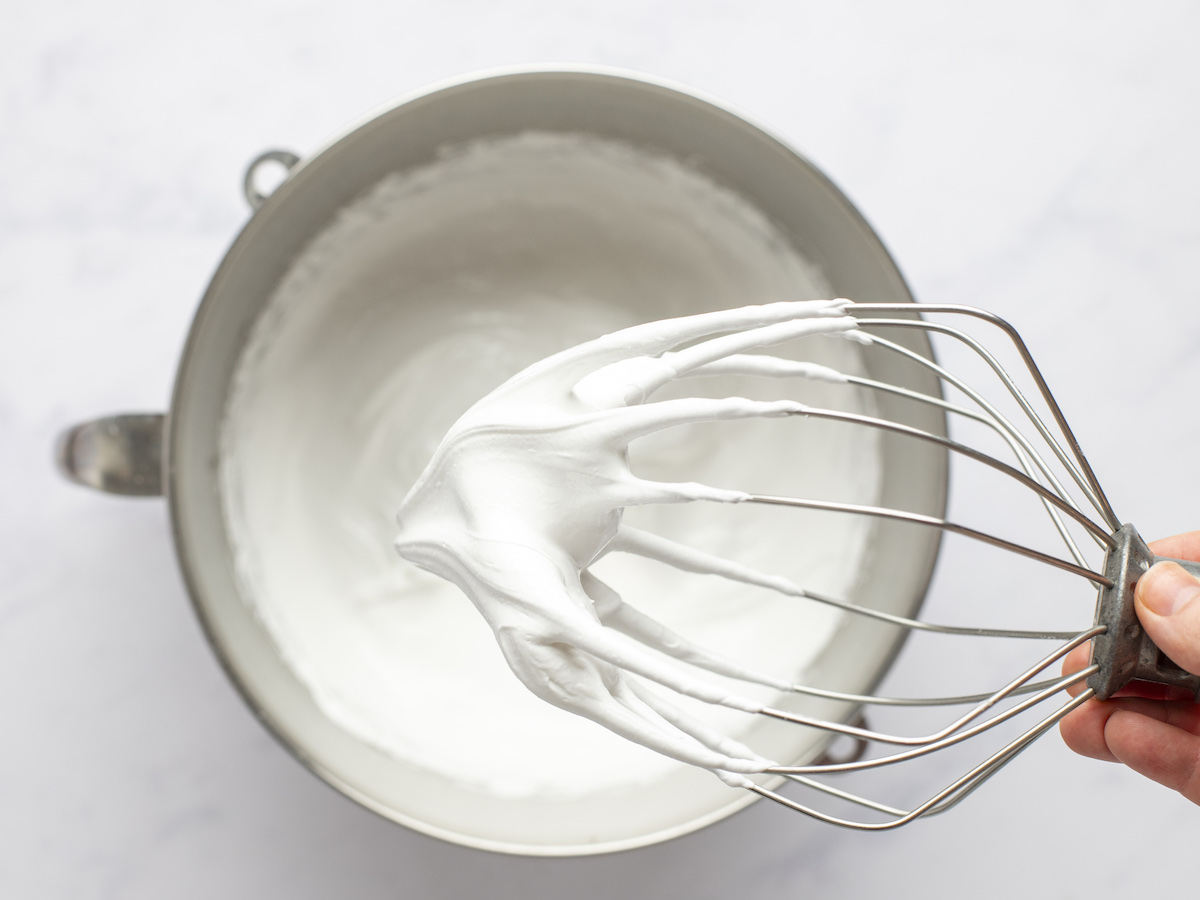
Add the vanilla and cornstarch.
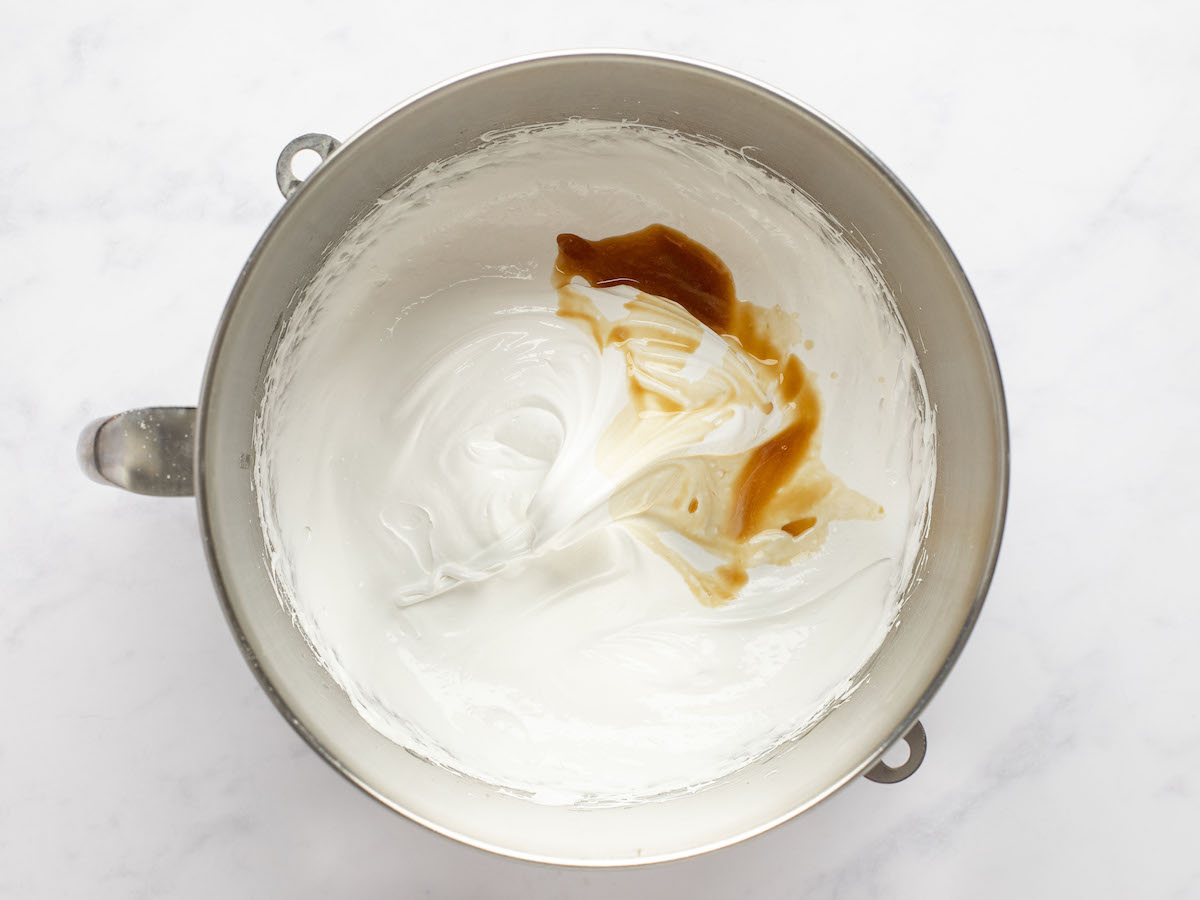
Beat for about 30 seconds more, until combined.
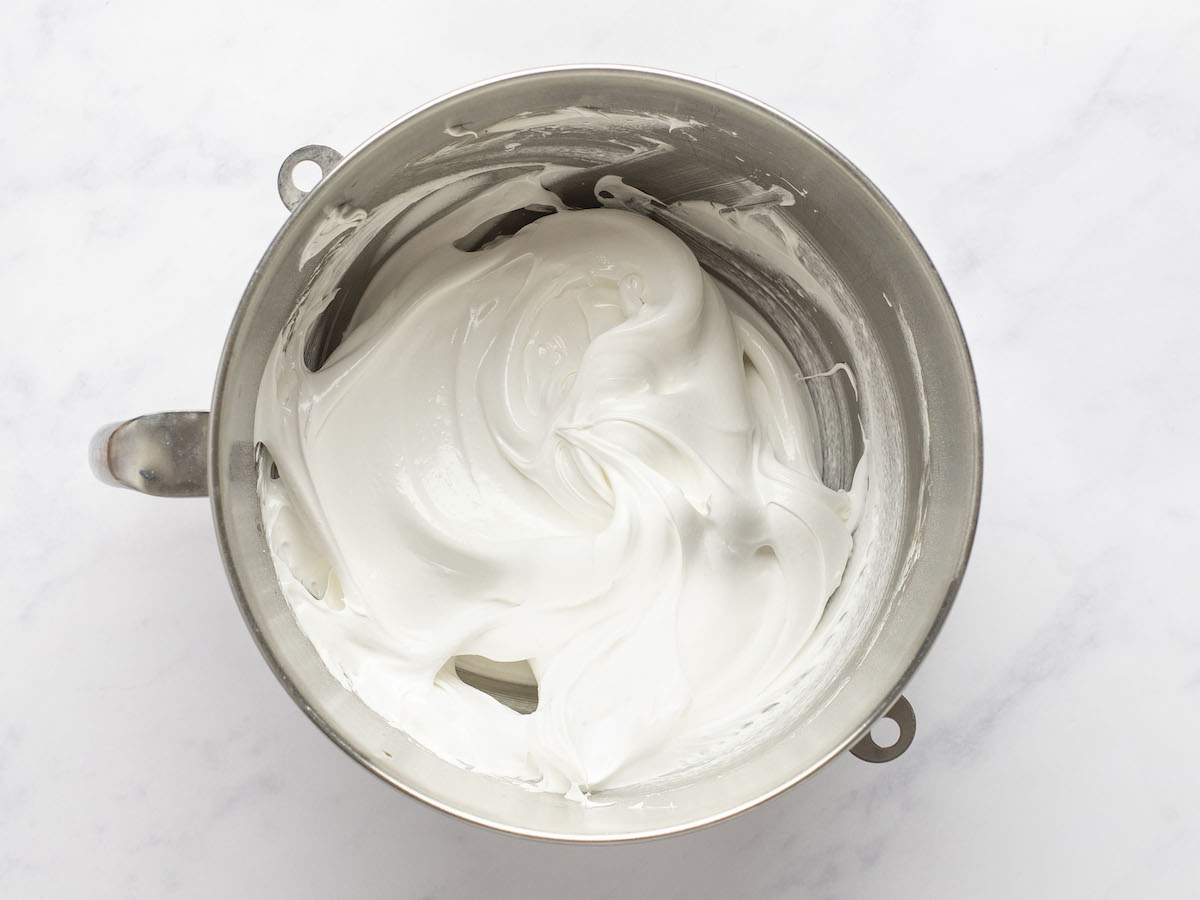
Adding a dab of meringue to each corner of the baking sheet. Lay the parchment paper on the baking sheet. The meringue acts as a glue to secure the parchment to the baking sheet. Mound the meringue onto the parchment and spread to fill the circle, ever-so-slightly indenting the center of the circle to fill with the whipped topping later on. Even out the top and sides just slightly—it shouldn’t be perfectly smooth or overworked.
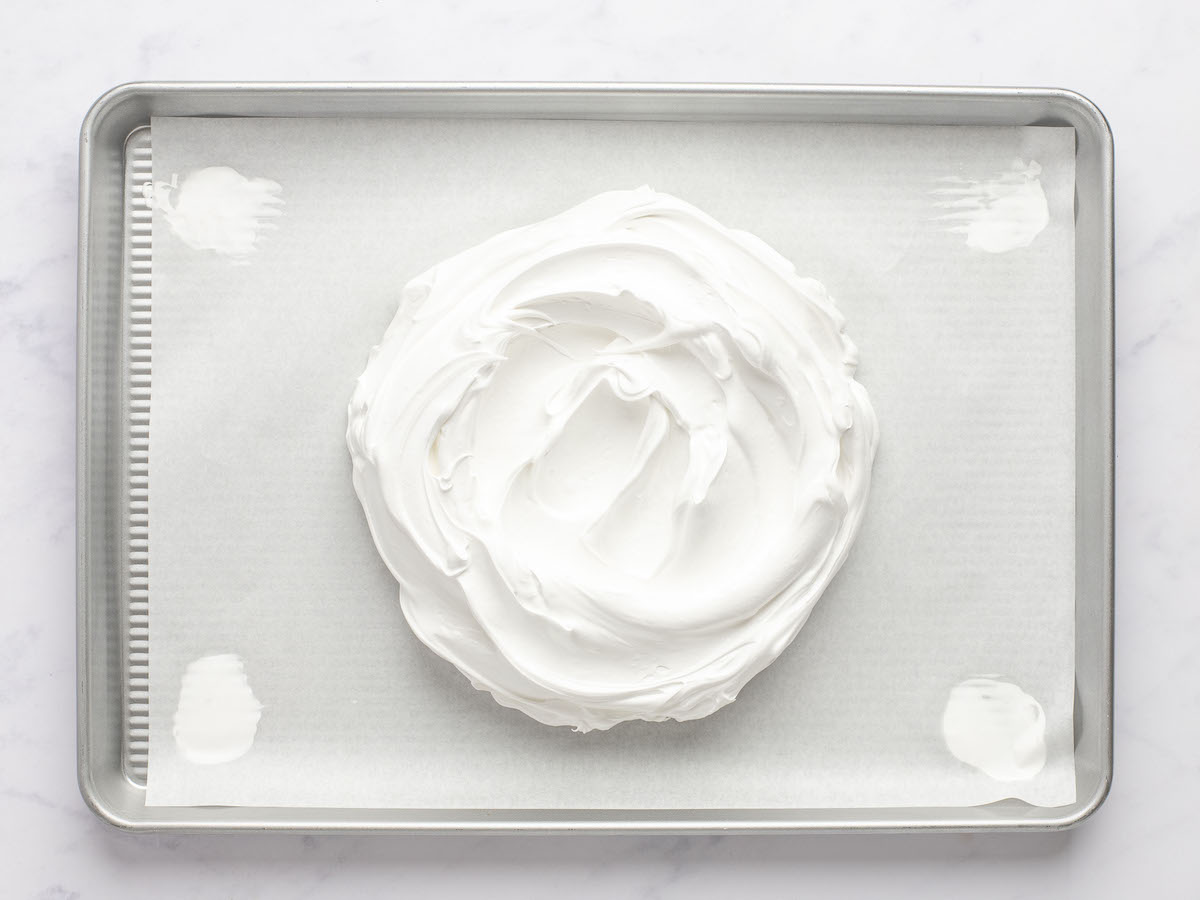
Place in the oven and bake for 85 to 90 minutes, or until the meringue is dry and crisp all over. Don’t worry if the top or edges are cracked — that’s normal and it all gets covered with whipped cream in the end. Turn off the oven, prop the oven door open, and leave the meringue in the oven to cool to room temperature for 1 hour. Transfer the pavlova to a cake stand or serving platter.
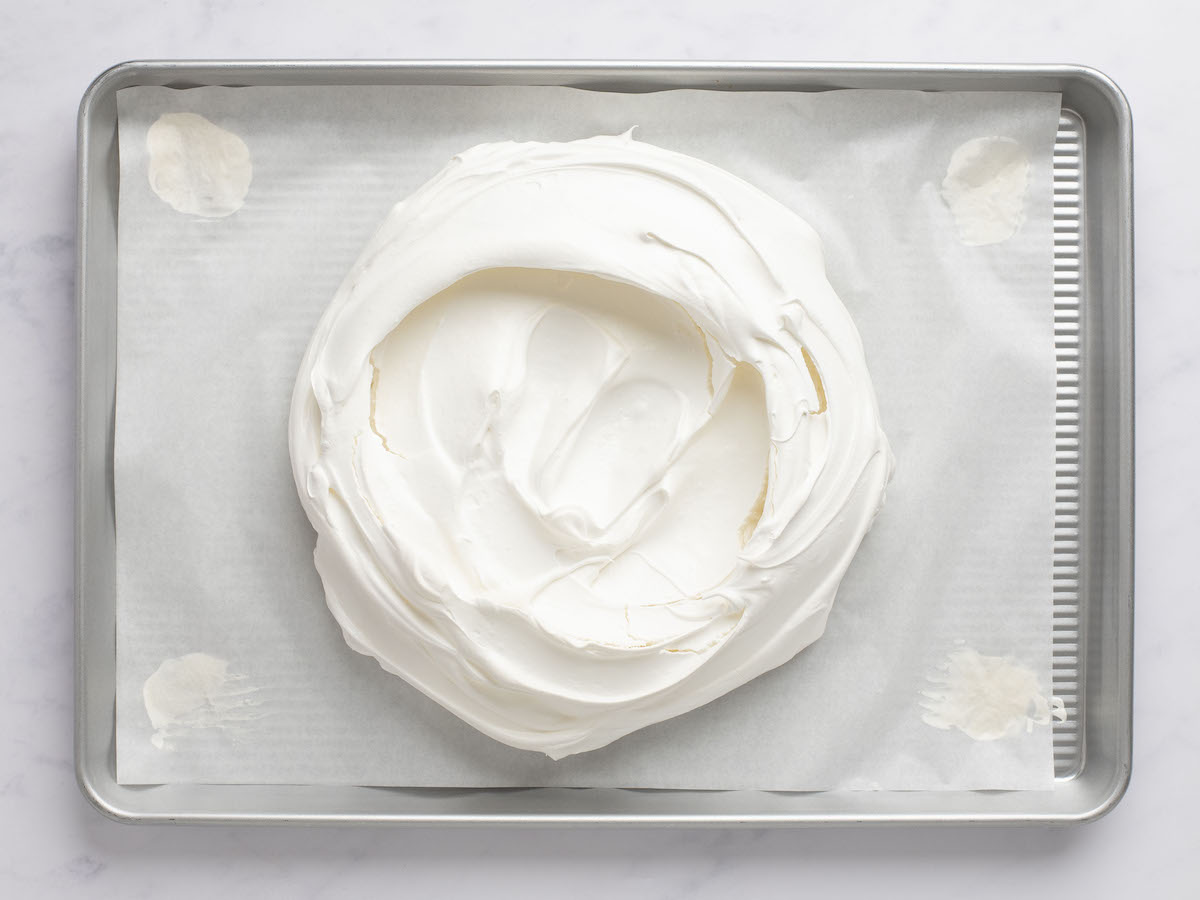
Step 2: Make the Whipped Topping
Wash your mixing bowl from the meringue. To the clean bowl, add mascarpone cheese, heavy cream, sugar, vanilla, and lemon zest.
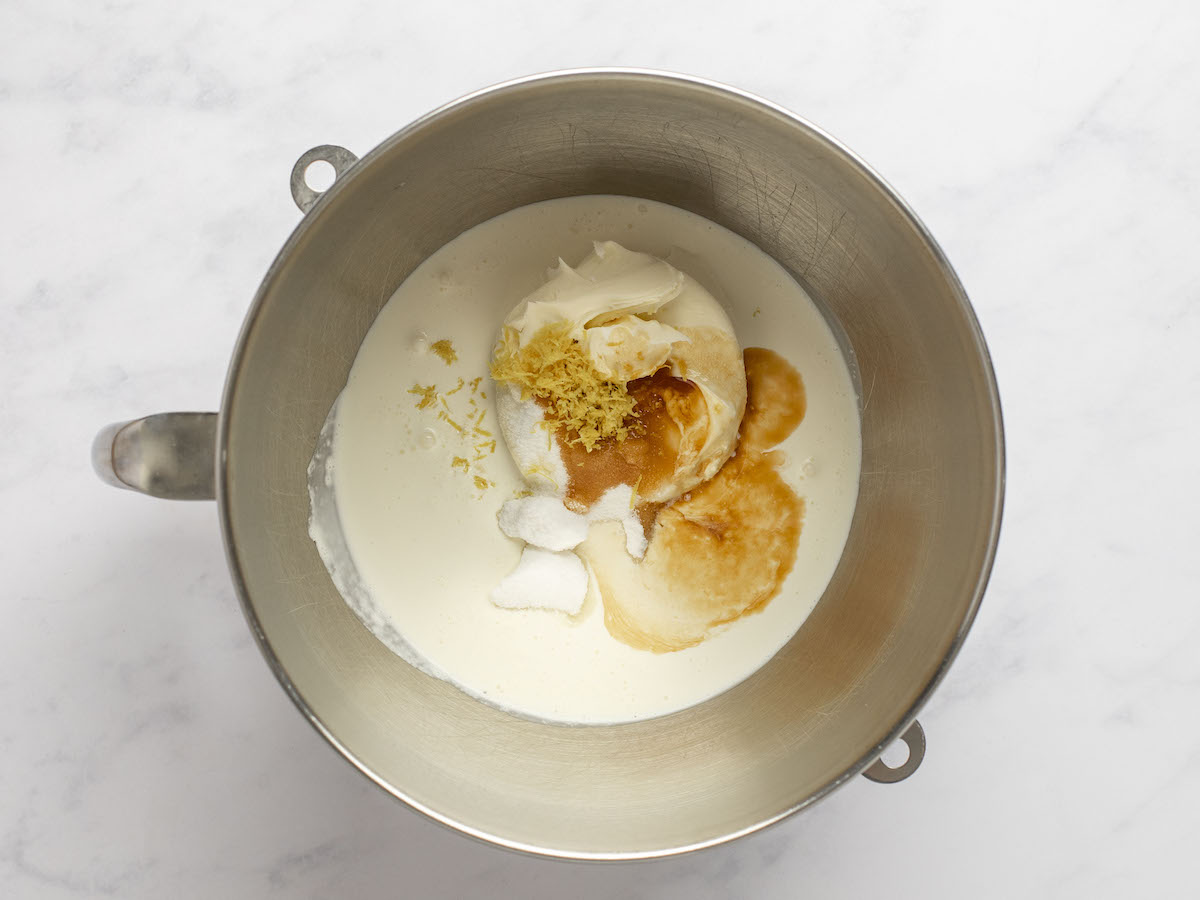
Whisk on low speed until combined, then increase the speed to medium-high and beat until billowy, medium-stiff peaks form, 1 to 2 minutes. Be cautious not to over-beat; the mixture should retain a smooth consistency without becoming overly stiff or taking on a curdled-like appearance.
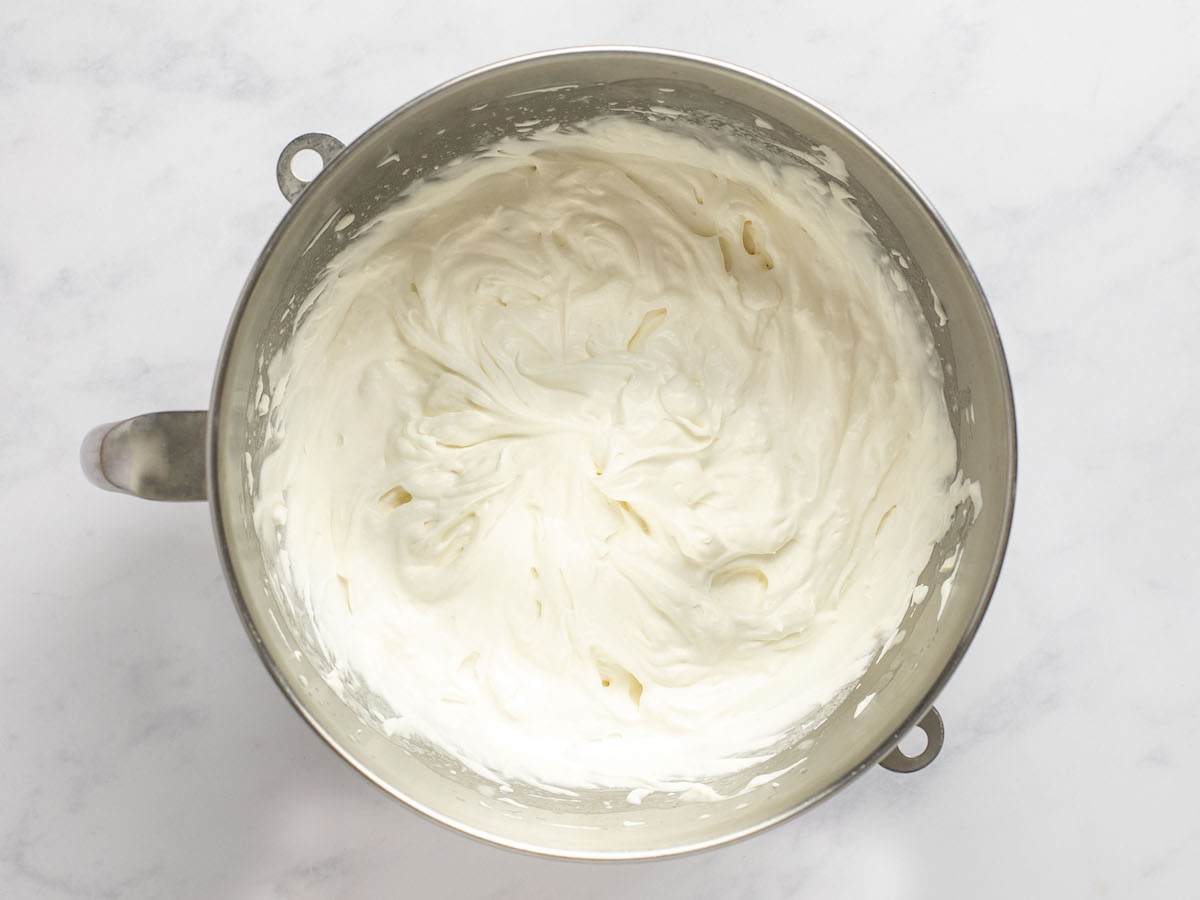
Step 3: Make the Macerated Berries (Optional)
If you’d like to top the pavlova with macerated berries rather than plain berries, in a medium bowl, gently mix the prepared berries with the lemon juice and sugar.
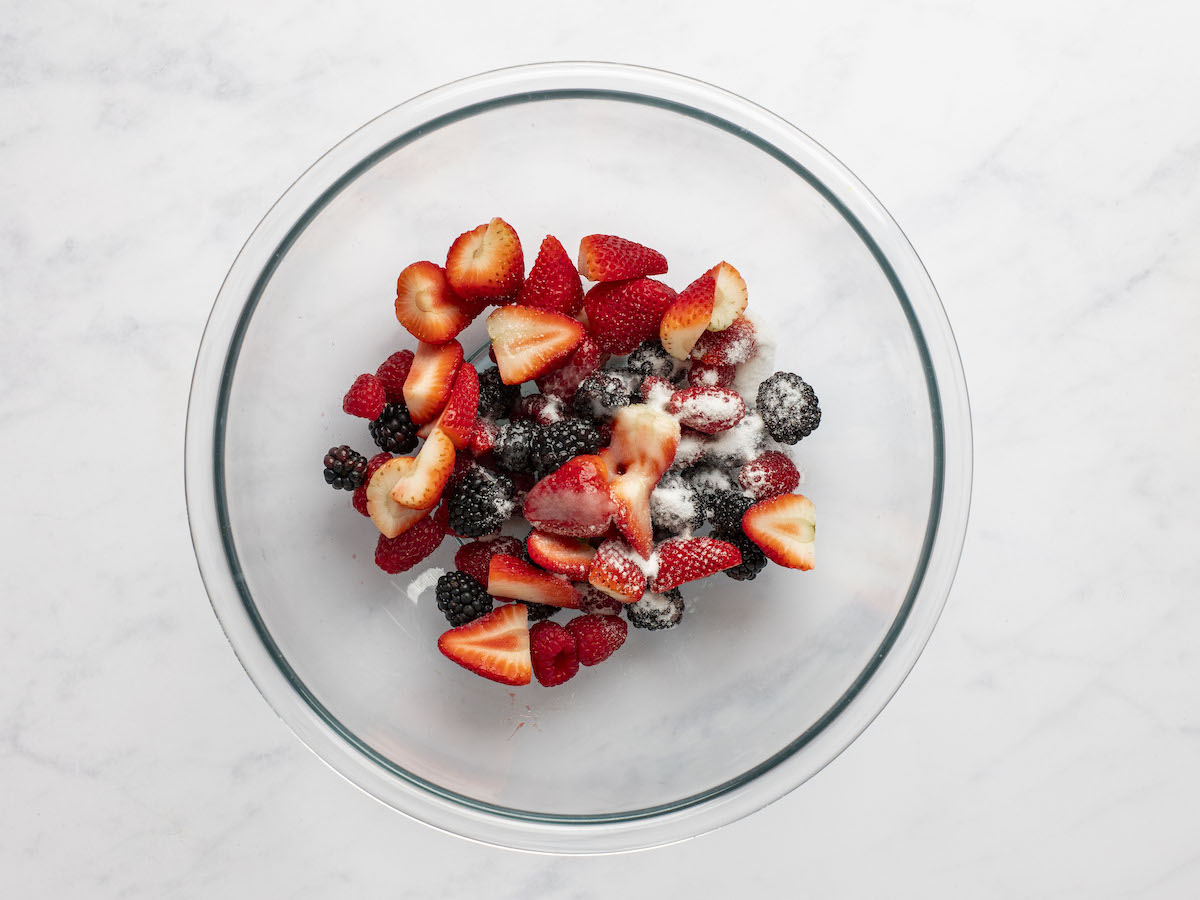
Allow the mixture to sit at room temperature for 30 minutes to 1 hour. During this time, the sugar will dissolve and the berries will release their juices, creating a light, natural syrup.
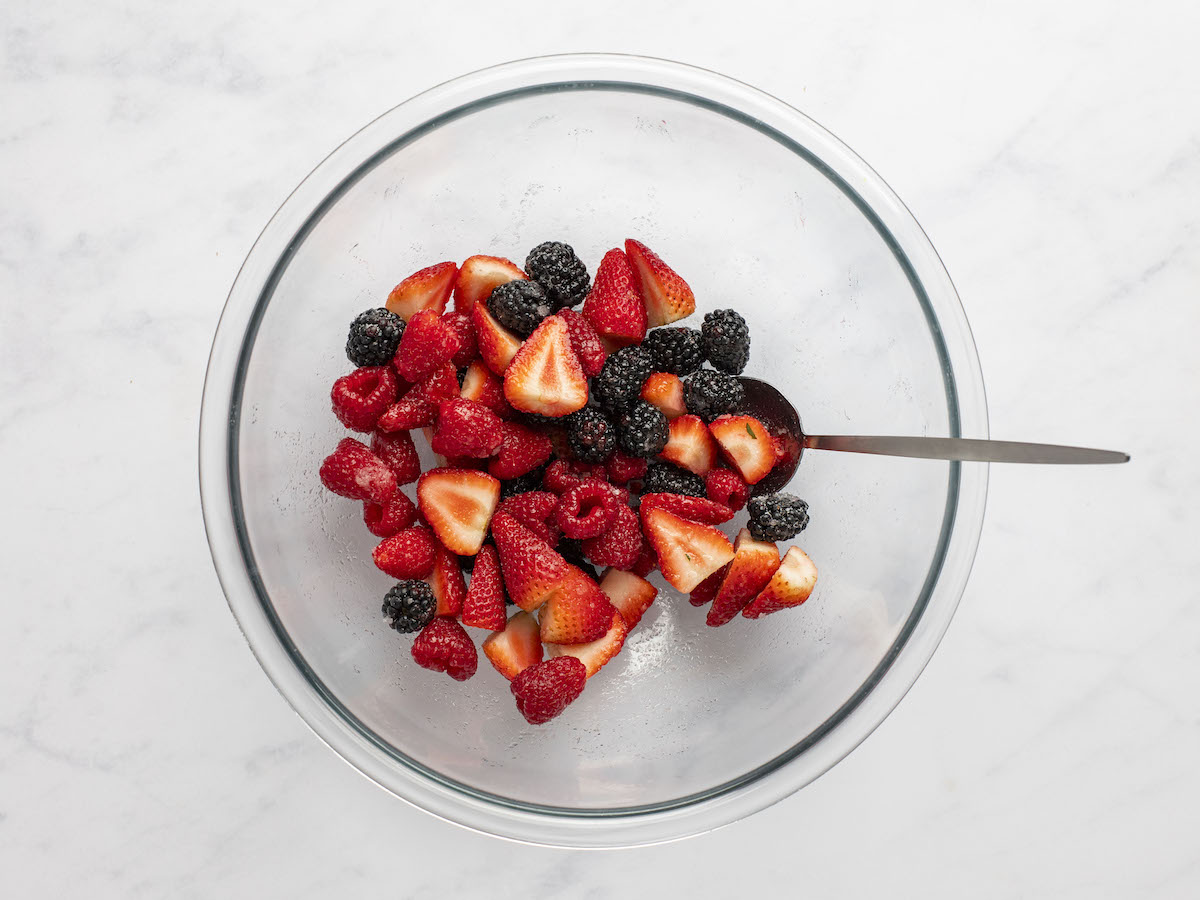
Step 4: Assemble
To assemble, carefully peel the meringue off of the parchment paper and place it on a serving platter. Alternatively, if the pavlova is difficult to remove, transfer it on the parchment to a platter (you can trim the parchment to a smaller square if necessary.)
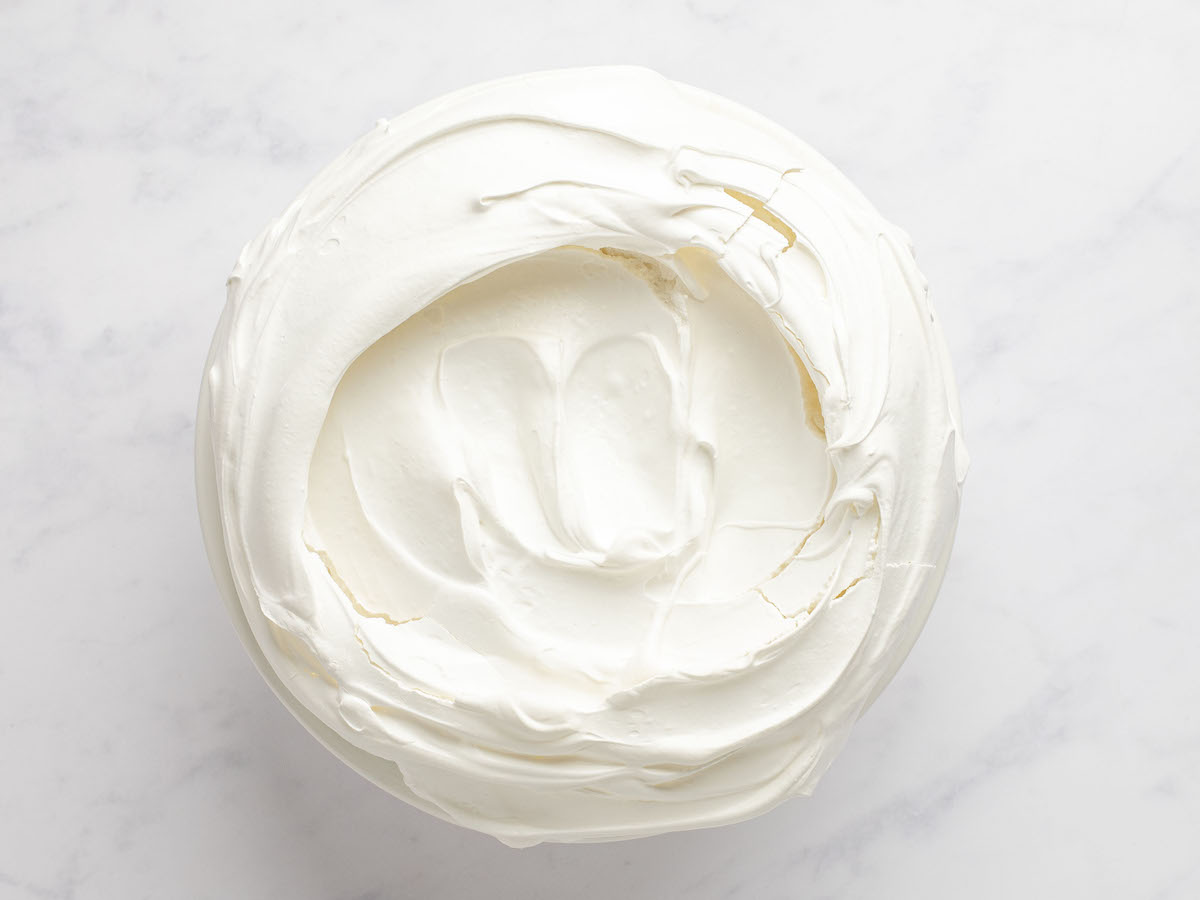
Mound the mascarpone cream onto the meringue and gently spread it out until it is about 1 inch from the edge (don’t worry if the meringue cracks in the process).
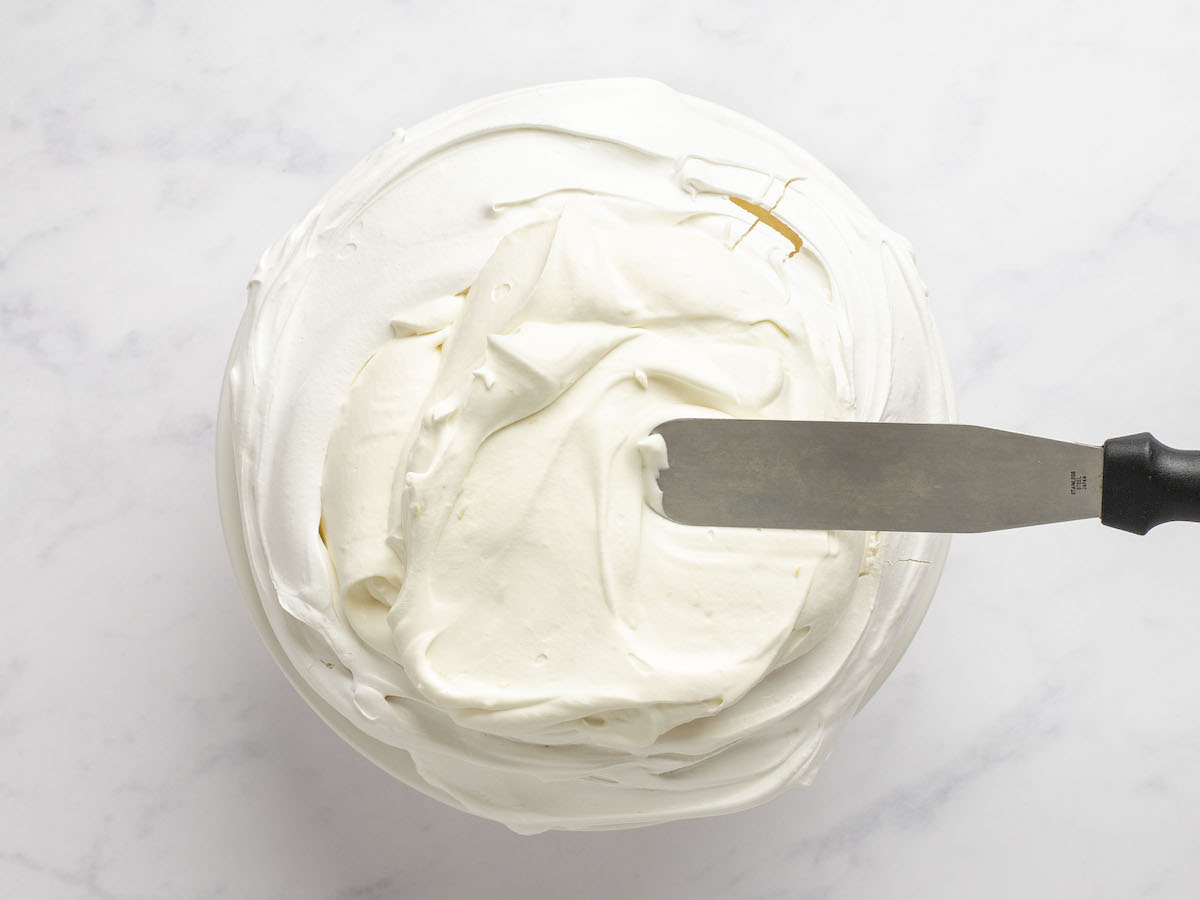
Top with the fresh or macerated berries, lemon zest, and fresh mint.
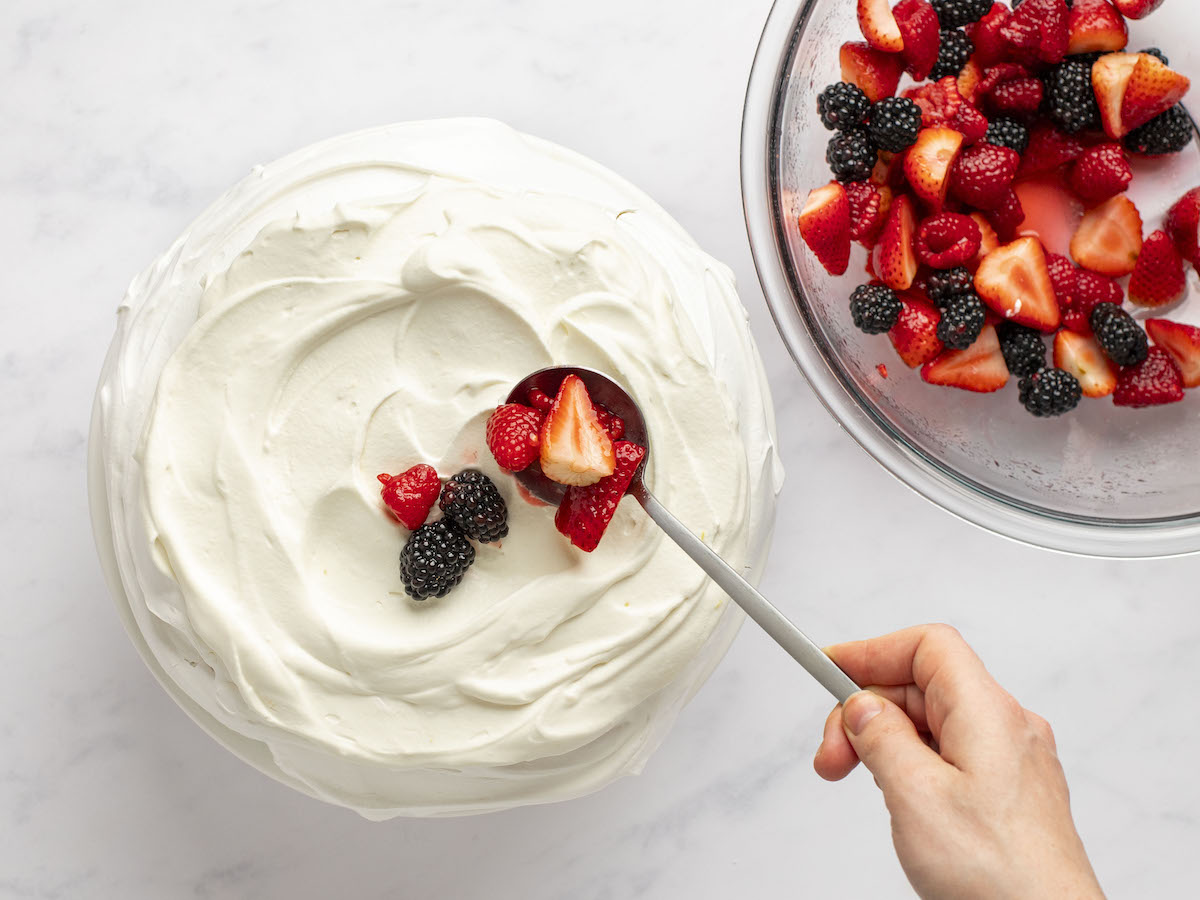
Frequently Asked Questions
Superfine sugar works best, as it dissolves more easily into the egg whites, preventing any graininess in the meringue. If you don’t have superfine sugar, no worries—simply place the same amount of granulated sugar in a food processor and pulse until fine, about 30 seconds.
You can omit the cornstarch to keep the recipe kosher for the holiday. While the texture might be slightly different without the cornstarch, your pavlova will still be perfectly delicious.
Sure! The meringue base can be made 1 day ahead of time and stored in an airtight container at room temperature; avoid refrigerating it, as the humidity can soften the structure. When ready to serve, carefully transfer the pavlova to a serving plate. Prepare and add the whipped topping and fresh fruit only just before serving to ensure the meringue remains crisp, preventing it from becoming soft due to the moisture from these toppings.
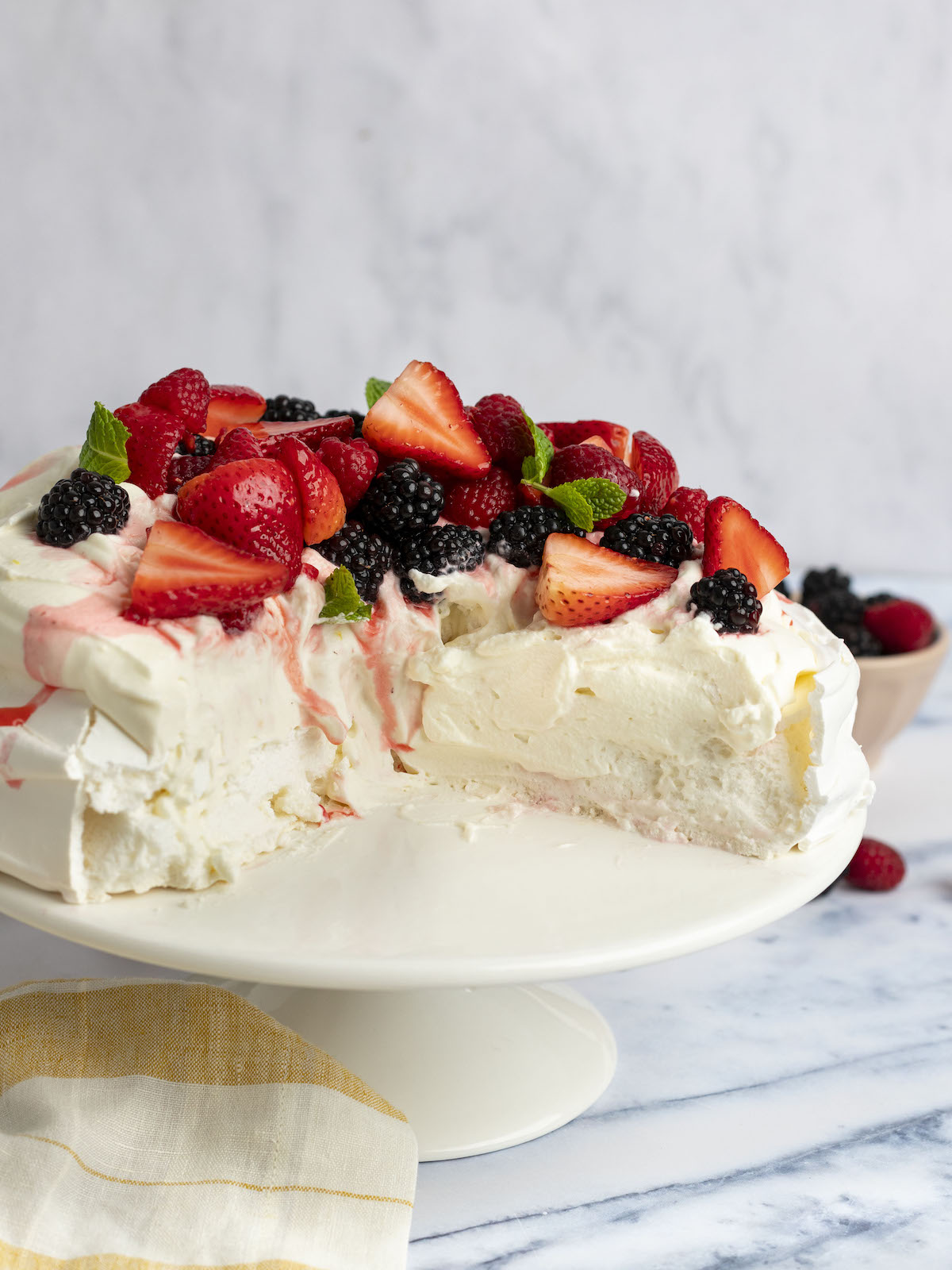
You May Also Like
Pavlova
Dress up your dessert table with a gorgeous pavlova—a cloud-like dessert featuring a crisp, marshmallowy meringue topped with rich whipped cream and vibrant berries, perfect for any special occasion. (Bonus: it’s gluten-free!)
Ingredients
For the Pavlova
- 6 large egg whites, at room temperature
- ⅛ teaspoon salt
- ½ teaspoon cream of tartar
- 1½ cups superfine sugar
- 1 teaspoon vanilla extract
- 1½ teaspoons cornstarch (see note)
For the Whipped Topping
- 8 ounces (1 cup) mascarpone cheese, cold
- 2 cups (1 pint) heavy cream, cold
- 6 tablespoons granulated sugar
- 1½ teaspoons vanilla extract
- 1 teaspoon (packed) finely grated lemon zest, from 1 lemon
- Pinch salt
For the Fruit Topping
- 1 pound (3 cups) mixed berries or macerated berries (see recipe below)
- A few fresh mint leaves (optional)
Instructions
For the Meringue
- Preheat the oven to 250°F and set an oven rack in the middle position. Line a baking sheet with parchment paper. Using a dark marker, draw a 9-inch diameter circle on the parchment paper by tracing around a 9-inch cake pan or plate. Flip the paper over so your meringue won't touch the marker. Set aside.
- Add the egg whites to the bowl of a stand mixer and beat on medium speed (6) until the egg whites become foamy, about 1 minute. Add the salt and cream of tartar and beat until the mixture forms soft peaks, about 2 minutes. Gradually add the granulated sugar, about one tablespoon at a time, continuing to beat (this should take about 1 minute). Once all the sugar is added, increase the speed to medium-high (8) and beat until the meringue is glossy and holds stiff peaks, 5 to 7 minutes more. (When you lift the beater out of the bowl, the meringue should form peaks that stand straight up without drooping.) Add the vanilla and cornstarch and beat for about 30 seconds more, until combined.
- Secure the parchment paper to the baking sheet by adding a dab of meringue under each corner to act as a glue. Mound the meringue onto the parchment inside the circle. Using a spatula or a butter knife, spread the meringue to fill the circle and ever-so-slightly indent the center of the circle to fill with the whipped topping later on. Even out the top and sides just slightly -- it shouldn’t be perfectly smooth or overworked.
- Place in the oven and bake for 85 to 90 minutes, or until the meringue is dry and crisp all over. Don't worry if the top or edges are cracked -- that's normal and it all gets covered with whipped cream in the end. Turn off the oven, prop the oven door open, and leave the meringue in the oven to cool to room temperature for 1 hour. (The meringue won’t collapse as much if it cools gradually.)
For the Whipped Topping
- Wash your mixing bowl from the meringue. To the clean bowl, add mascarpone cheese, heavy cream, sugar, vanilla, and lemon zest. Whisk on low speed until combined, then increase the speed to medium-high and beat until billowy, medium-stiff peaks form, 1 to 2 minutes. Be cautious not to over-beat; the mixture should retain a smooth consistency without becoming overly stiff or taking on a curdled-like appearance.
For Assembling
- To assemble, carefully peel the meringue off of the parchment paper and place it on a serving platter. Alternatively, if the pavlova is difficult to remove, transfer it on the parchment to a platter (you can trim the parchment to a smaller square if necessary.) Mound the mascarpone cream onto the meringue and gently spread it out until it is about 1 inch from the edge (don't worry if the meringue cracks in the process). Top the pavlova with the fresh or macerated berries and fresh mint.
- Note: The cornstarch in this pavlova recipe serves to stabilize the egg whites and help create a fluffy, marshmallow-like center beneath the crisp exterior. However, if you're preparing this dessert for Passover, you can omit the cornstarch to keep the recipe kosher for the holiday. While the texture might be slightly different without the cornstarch, your pavlova will still be perfectly delicious.
- To Make Mini Pavlovas: Shape 8 to 10 small meringues with a slight indentation in the center (to hold the whipped topping later) on two parchment-lined baking sheets, leaving space for them to spread a bit. Position the sheets in the upper and lower thirds of the oven. Bake for 50 to 55 minutes, or until the pavlovas are crisp and dry. Then, turn off the oven and prop open the door slightly; let the meringues cool inside to room temperature, which should take about one hour.
- To Make Macerated Berries: If you'd like to top the pavlova with macerated berries, begin with 1 pound (3 cups) mixed berries, 1 tablespoon lemon juice and 2 tablespoons granulated sugar. If using strawberries, hull them and cut into halves or quarters if large. Leave smaller berries like blueberries, raspberries, and blackberries whole. Ensure all the berries are clean and dry. In a medium bowl, gently mix the prepared berries with the lemon juice and sugar. Allow the mixture to sit at room temperature for 30 minutes to 1 hour. During this time, the sugar will dissolve and the berries will release their juices, creating a light, natural syrup.
- Make-Ahead Instructions: The meringue base can be made 1 day ahead of time and stored in an airtight container at room temperature; avoid refrigerating it, as the humidity can soften the structure. The whipped topping can be prepared and refrigerated up to 2 hours before serving. When ready to serve, carefully transfer the pavlova to a serving plate. Add the whipped topping and fresh fruit only just before serving to ensure the meringue remains crisp, preventing it from becoming soft due to the moisture from these toppings.
- Nutritional Note: The nutritional information includes the fresh berries and mint.
Nutrition Information
Powered by ![]()
- Per serving (10 servings)
- Calories: 422
- Fat: 25 g
- Saturated fat: 16 g
- Carbohydrates: 46 g
- Sugar: 43 g
- Fiber: 1 g
- Protein: 5 g
- Sodium: 160 mg
- Cholesterol: 77 mg
This website is written and produced for informational purposes only. I am not a certified nutritionist and the nutritional data on this site has not been evaluated or approved by a nutritionist or the Food and Drug Administration. Nutritional information is offered as a courtesy and should not be construed as a guarantee. The data is calculated through an online nutritional calculator, Edamam.com. Although I do my best to provide accurate nutritional information, these figures should be considered estimates only. Varying factors such as product types or brands purchased, natural fluctuations in fresh produce, and the way ingredients are processed change the effective nutritional information in any given recipe. Furthermore, different online calculators provide different results depending on their own nutrition fact sources and algorithms. To obtain the most accurate nutritional information in a given recipe, you should calculate the nutritional information with the actual ingredients used in your recipe, using your preferred nutrition calculator.
Gluten-Free Adaptable Note
To the best of my knowledge, all of the ingredients used in this recipe are gluten-free or widely available in gluten-free versions. There is hidden gluten in many foods; if you're following a gluten-free diet or cooking for someone with gluten allergies, always read the labels of your ingredients to verify that they are gluten-free.

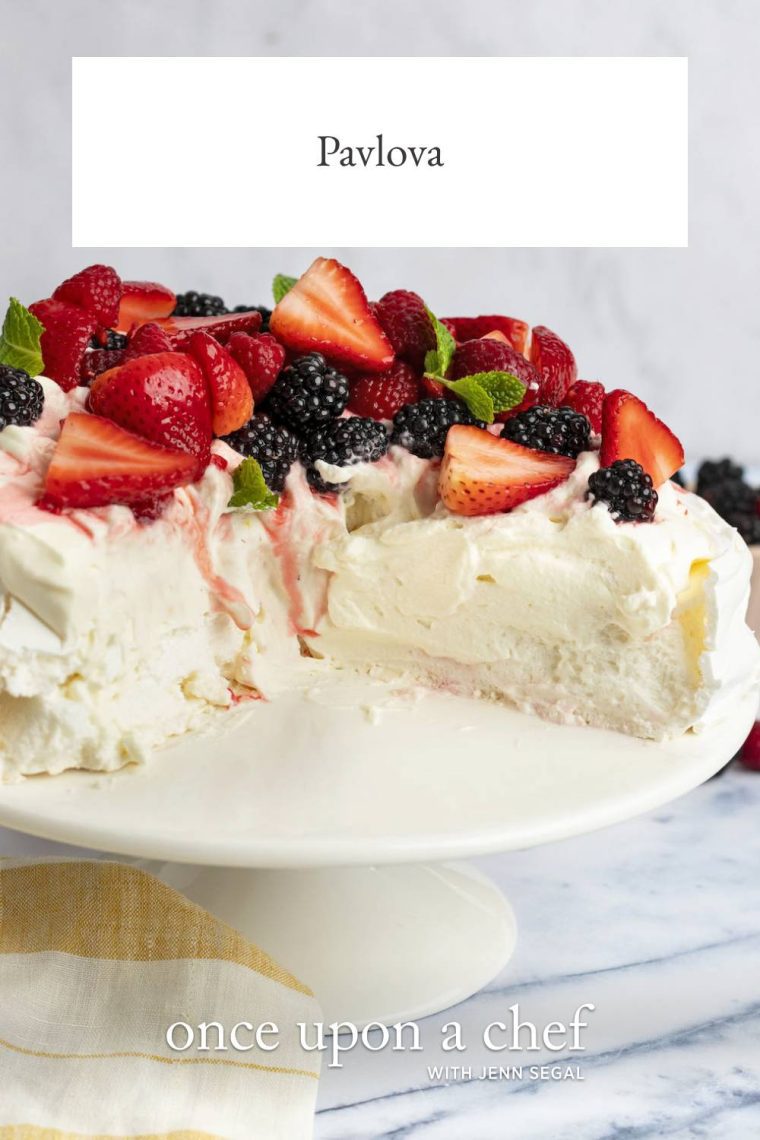
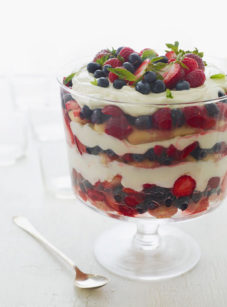
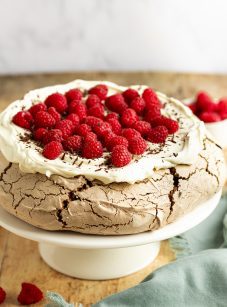
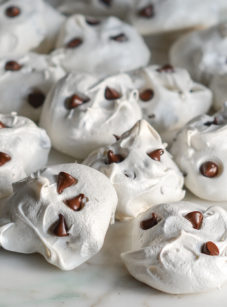
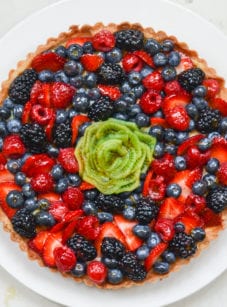
So yummy!! I love this recipe. Mine did not collapse during baking, however the outside part looks a tad grainy. I kept to the recommended time of whipping so I’m not sure if I overdid it? Is it fine to still eat it? Thanks!!
Glad you like it (and yes, it’s definitely safe to eat). Regarding the graininess, did you use superfine sugar in the meringue?
This dessert turned out so beautifully – I even impressed myself!
I am making Pavlova for a school project. I was wondering, what is the max amount of time that you can make Pavlova ahead?
Hi Vivi, the meringue can be made up to 1 day ahead and the whipped topping 2 hours ahead. See the bottom of the recipe for more specific make-ahead guidance.
Hi Jenn, Pavlova is my favorite dessert so I tried for the first time (never made it before) to make it using your recipe. My family was pleasantly surprised by how delicious it turned out. THANK YOU! Easy to follow and very delicious.
Do you think I could get the same results if I halved the ingredients for a 4 piece serving?
Sure!
Would it be ok to substitute softened cream cheese for the mascarpone cheese?
Sure – enjoy!
Hi Jenn,
I’m a big fan of pavlova, and many others have become fans via your double-chocolate pavlova recipe. I always appreciate the creaminess and richness of the added mascarpone (we have to make our own where we live, but it’s always worth it). I have been on the hunt for a pavlova recipe where the base might texturally mimic what you’re able to achieve with the chocolate base, but without the chocolate. I haven’t found anything yet. I am wondering if you have any ideas about how to take this basic pavlova recipe and make the base more similar to your double-chocolate recipe. I’ve thought about white chocolate but am concerned it would be too sweet or not produce the same texture. Any suggestions would be greatly appreciated! Thanks!
Hi Adrienne, this Pavlova actually has a similar texture to my chocolate one. If you’d like, you can add 2 ounces of chopped white chocolate to this one. Hope that helps!
Great! Thank you! Looking forward to it.
Any ideas on an adaptation for zero carb sugar like monk fruit? My family is doing keto, and this would be a great dessert if I could make it without sugar. Thanks.
Hi Vicky, I’m not sure how using a sugar substitute like monk fruit would impact the Pavlova. For a more predictable result, I’d use a Pavlova recipe that calls for monk fruit. I looked online and saw that there are some options and they look fairly similar to this recipe. Good luck!
Would potato starch work in lieu of corn starch for passover?
Hi Meryl, I haven’t tried it so can’t say for sure, but I have made it without the cornstarch and it works just fine. The cornstarch gives the meringue a slightly more marshmallowy texture, but it’s barely noticeable so I would just leave it out for Passover. Hope that helps!